Related Research Articles

Thodupuzha (തൊടുപുഴ) is a municipality in Idukki district in the Kerala state of India, spread over an area of 35.43 km2. Thodupuzha is 57 km (35 mi) from Kottayam and 60 km (37 mi) south east of Kochi. Thodupuzha is 200 km from the state capital, Trivandrum. Geographical classification of Thodupuzha Region is Malanad or Idanad.
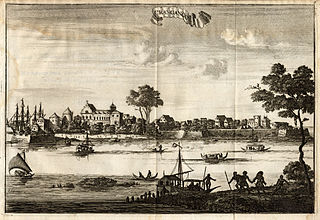
Kodungallur is a historically significant town and a municipality on the banks of river Periyar on the Malabar Coast in Thrissur district of Kerala, India. It is situated 29 kilometres (18 mi) north of Kochi (Cochin) by National Highway 66. Kodungallur, being a port city at the northern end of the Kerala lagoons, was a strategic entry point for the naval fleets to the extensive Kerala backwaters.

Kingdom of Cochin was a late medieval kingdom and later princely state on the Malabar Coast, South India. Once controlling much of the territory between Ponnani and Thottappally, the Cochin kingdom shrank to its minimal extent as a result of invasions by the Zamorin of Calicut. When Portuguese armadas arrived in India, the Kingdom of Cochin had lost its vassals like Edapalli, Cranganore etc. to the Zamorin and was looking for an opportunity to preserve the independence of Cochin which was at risk. King Unni Goda Varma warmly welcomed Pedro Álvares Cabral on 24 December 1500 and negotiated a treaty of alliance between Portugal and the Cochin kingdom, directed against the Zamorin of Calicut. Cochin became a long-time Portuguese ally (1503–1663) providing assistance against native overlords. After the Portuguese, the Dutch East India Company (1663–1795) was an ally of Cochin. This was followed by the English East India Company, having suzerainty over the Cochin state.
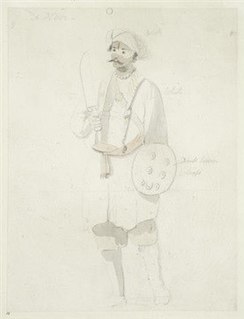
The Nair, also known as Nayar, are a group of Indian Hindu castes, described by anthropologist Kathleen Gough as "not a unitary group but a named category of castes". The Nair include several castes and many subdivisions, not all of whom historically bore the name 'Nair'. These people lived, and continue to live, in the area which is now the Indian state of Kerala. Their internal caste behaviours and systems are markedly different between the people in the northern and southern sections of the area, although there is not very much reliable information on those inhabiting the north.

Anizham Thirunal Marthanda Varma ; 1706 – 7 July 1758, known as the Maker of Modern Travancore, was ruler of the Indian kingdom of Travancore (Venadu) from 1729 until his death in 1758. He was succeeded by Rama Varma (1758–98).
Paliath Achan or Paliyath Achan is the name given to the oldest male member of the Paliam family, a Nair chieftain family from the Indian state of Kerala that figured prominently in the history of the region.

University of Kerala, formerly the University of Travancore, is an affiliating university located in Thiruvananthapuram, capital of the state of Kerala, India. It was established in 1937, long before the birth of the state of Kerala India, by a promulgation of the Maharaja of Travancore, Chithira Thirunal Balarama Varma who was also the first Chancellor of the university: C. P. Ramaswami Iyer
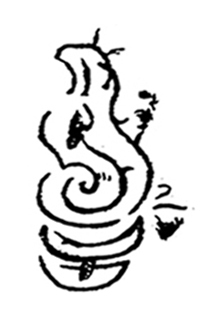
Venad was a medieval kingdom lying between the Western Ghat mountains and the Arabian Sea on the south-western tip of India with its headquarters at the port city of Kollam/Quilon.Their palace was located at Keezhperoor and family temple was Thirupalkadal Sreekrishnaswamy Temple. It was one of the major principalities of Kerala, along with kingdoms of Kannur (Kolathunadu), Kozhikode and Kochi (Perumpadappu) in medieval and early modern period.

The Battle of Colachel was fought on 10 August 1741 [O.S. 31 July 1741] between the Indian kingdom of Travancore and the Dutch East India Company, during the Travancore-Dutch War. King Marthanda Varma's (1729–1758) forces defeated the Dutch East India Company's forces led by Admiral Eustachius De Lannoy on 10 August 1741. It was the first time in Indian history that an Asian country defeated a European naval force. The Dutch never recovered from the defeat and no longer posed a large colonial threat to India.
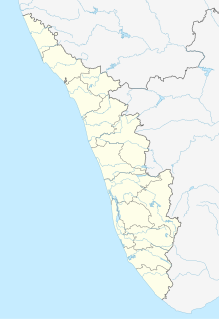
Kaipuzha is a small village in Kottayam District and sub-district in the Indian state of Kerala. As of the 2001 census, it had a population of 6,991 in 1,565 households.
Odanad was a feudal state in late medieval Kerala. It was established in the 11th century, and disestablished in 1746 when it became part of Travancore after Venad King Marthanda Varma's northern expedition. The last king of Odanad was King Kotha Varma. At the time of its dissolution, it was composed of the present-day taluks of Mavelikkara, Karthikapally, Chenganur in the Alappuzha district and Karunagapally in the Kollam district. In the 16th century, the capital of Odanad was moved from Kandiyoor-Muttom, Mavelikkara to Eruva and Krishnapuram, near Kayamkulam, which led to the state being called Kayamkulam. After this shift, Kayamkulam became the commercial centre of Odanad, while Mavelikkara remained its cultural centre.
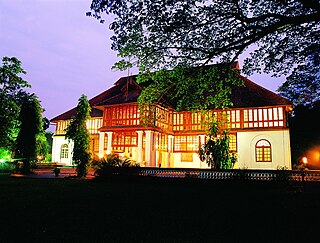
The term Kerala was first epigraphically recorded as Ketalaputo (Cheras) in a 3rd-century BCE rock inscription by emperor Ashoka of Magadha. It was mentioned as one of four independent kingdoms in southern India during Ashoka's time, the others being the Cholas, Pandyas and Satyaputras. Kerala was alternatively called Kerala as well as Malabar. Until the arrival of British, the term Malabar was used as a general name for Kerala. From the time of Cosmas Indicopleustes itself, the Arab sailors used to call Kerala as Male. Al-Biruni must have been the first writer to call this state Malabar. The Arab writers had called this place Malibar, Manibar, Mulibar, and Munibar. Malabar is reminiscent of the word Malanad which means the land of hills. According to William Logan, the word Malabar comes from a combination of the Malayalam word Mala (hill) and the Persian/Arabic word Barr (country/continent). The Cheras transformed Kerala into an international trade centre by establishing trade relations across the Arabian Sea with all major Mediterranean and Red Sea ports as well those of the Far East. The early Cheras collapsed after repeated attacks from the neighboring Cholas and Rashtrakutas.

Kottayam (കോട്ടയം)is a city in the Indian state of Kerala. Kottayam literally means the interior of a fort—Kotta + Akam. Flanked by the Western Ghats on the east and the Vembanad Lake and paddy fields of Kuttanad on the west, Kottayam is a place that is known for extraordinary qualities. It is the district headquarters of Kottayam district, located in south-west Kerala. Kottayam is located in the basin of the Meenachil River at an average elevation of 3 metres (9.8 ft) above sea level, and has a moderate climate. It is located 150 kilometres (93 mi) north of the state capital Thiruvananthapuram.

Kochi is a metro city located in the Ernakulam District in the Indian state of Kerala. Kochi, which is the largest city in Kerala is located about 200 km from Trivandrum capital of Kerala.

Thrissur is the administrative capital of Thrissur District situated in the central part of Kerala state, India. Thrissur district was formed on 1 July 1949. It is an important cultural centre, and is known as the Cultural Capital of Kerala. It is famous for the Thrissur Pooram festival, one of the most colourful and spectacular temple festival of Kerala. From ancient times, Thrissur has played a significant part in the political, economical and cultural history of Indian sub continent and South East Asia. It has opened the gates for Arabs, Romans, Portuguese, Dutch and English. Thrissur is where Christianity, Islam and Judaism entered the Indian sub continent, when Thomas the Apostle arrived in 52 CE and the location of country's first Mosque in the 7th century.

The Travancore–Dutch War was a war between the Dutch East India Company (VOC) and the Indian kingdom of Travancore, culminating in the Battle of Colachel in 1741.

The Kingdom of Thekkumkur was an independent kingdom in the southern part of Kerala in India from 1103 CE until 1750 CE. It was ruled by the Thekkumkur Royal Family. Thekkumkur lies between the Meenachil River and the Pamba River, from the Western Ghats to the Vembanad Kayal. Thekkumkur emerges as a result of administrative changes in the princely states at the end of the Chera Kulasekhara dynasty of Mahodayapuram. The literal meaning of the title is the southern regent and the attribute southern distinguished them from another kingdom known as Vadakkumkur which bordered it in the northern side. The royal household, Thekkumkur Kovilakam, were at Vennimala and Manikandapuram near Puthuppally, later it shifted to Neerazhi Palace at Puzhavathu of Changanassery and Thalilkotta at Thaliyanthanapuram (Kottayam).

Dutch Malabar, also known by the name of its main settlement Cochin, was the title of a commandment of the Dutch East India Company on the Malabar Coast between 1661 and 1795, and is part of what is today collectively referred to as Dutch India. Dutch presence in the region started with the capture of Portuguese Quilon, and ended with the occupation of Malabar by the British in 1795. They possessed military outposts in 11 locations: Alleppey, Ayacotta, Chendamangalam, Pappinivattom, Ponnani, Pallipuram, Cranganore, Chetwai, Cannanore, Cochin, and Quilon.
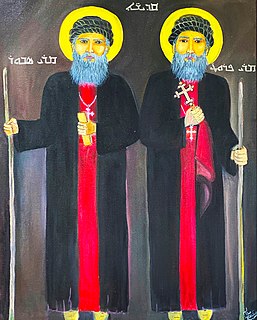
Quilon or Coulãopronunciation (help·info), officially Kollampronunciation (help·info) is one of the ancient civilizations in India. It is one of the oldest port cities in the Malabar Coast and was the capital city of historic Venad Kingdom and Travancore Kingdom. Quilon was once an important trading port in India. It was also known as Desinganadu. It is now known as the "Cashew Capital of the World".

Malappuram is one of the 14 districts in the South Indian state of Kerala. The district has an eventful history starting from the pre-historic times. During the early medieval period, the district was the home to two of the four major kingdoms that ruled Kerala. Perumpadappu was the original hometown of the Kingdom of Cochin, which is also known as Perumbadappu Swaroopam, and Nediyiruppu was the original hometown of the Zamorin of Calicut, which is also known as Nediyiruppu Swaroopam.
References
- ↑ Census of India, 2001: Wayanad. Controller of Publications. 2004.
- ↑ Nair, K. K. (2013). By Sweat and Sword: Trade, Diplomacy and War in Kerala Through the Ages. KK Nair. p. 157. ISBN 9788173049736.
- ↑ AIYA, V. NAGAM (1906). TRAVANCORE STATE MANUAL: with foreword by VED from VICTORIA INSTITUTIONS. VICTORIA INSTITUTIONS, Aaradhana, DEVERKOVIL 673508 India www.victoriainstitutions.com. p. 48.
